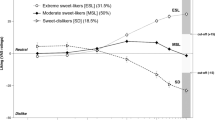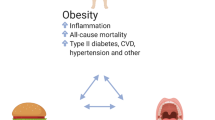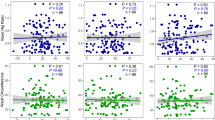Abstract
Background:
Sensory factors are important determinants of appetite and food choices but little is known about the relationship between body weight and sensory capabilities.
Objective:
To investigate the relationship between measured body weights, misreporting of body weight and sensory capabilities.
Design:
In a cross-sectional sensory study, body weight was assessed by measured and self-reported body weight in healthy men (n=130) and women (n=181). Sensory capabilities were assessed as odour detection and identification, and detection for salty, sweet, sour and bitter taste.
Results:
Odour detection, odour identification and taste perception scores were lower in subjects with a BMI ⩾28 kg/m2 than in subjects with a BMI <28 kg/m2 in the age group <65 years whereas in subjects ⩾65 years scores were higher in subjects with a BMI ⩾28 kg/m2 than in subjects with a BMI <28 kg/m2 (BMI*age group: P=0.015, 0.053 and 0.015, respectively). Independent of age, scores were highest in under reporters of body weight (P=0.008, 0.001 and 0.017). Differences in taste perception could be attributed to sour (P=0.015) and bitter (P=0.026) perception, but not to salty or sweet perception.
Conclusion:
Relationship between sensory capabilities and body mass is age dependent. Compared to overweight subjects, the sensory capabilities of normal weight individuals appear to be higher (<65 years) and lower (⩾65 years). At any age, however, subjects who under reported their body weight show higher sensory capabilities.
This is a preview of subscription content, access via your institution
Access options
Subscribe to this journal
Receive 12 print issues and online access
$259.00 per year
only $21.58 per issue
Buy this article
- Purchase on Springer Link
- Instant access to full article PDF
Prices may be subject to local taxes which are calculated during checkout



Similar content being viewed by others
References
Anderson GH (1995). Sugars, sweetness, and food intake. Am J Clin Nutr 62 (Suppl 1), 195S–201S, discussion 201S–202S.
Astrup A (2001). Healthy lifestyles in Europe: prevention of obesity and type II diabetes by diet and physical activity. Public Health Nutr 4, 499–515.
Bellisle F (2003). Why should we study human food intake behaviour? Nutr Metab Cardiovasc Dis 13, 189–193.
Brand-Miller JC, Holt SH, Pawlak DB, McMillan J (2002). Glycemic index and obesity. Am J Clin Nutr 76, 281S–285S.
Cain WS, Reid F, Stevens JC (1990). Missing ingredients: aging and the discrimination of flavor. J Nutr Elder 9, 3–15.
Davenport RJ (2004). The flavor of aging. Sci Aging Knowledge Environ 2004, ns1.
Dessirier JM, Nguyen N, Sieffermann JM, Carstens E, O’Mahony M (1999). Oral irritant properties of piperine and nicotine: psychophysical evidence for asymmetrical desensitization effects. Chem Senses 24, 405–413.
Doty RL (1994). Olfaction and multiple chemical sensitivity. Toxicol Ind Health 10, 359–368.
Drewnowski A (1997). Taste preferences and food intake. Annu Rev Nutr 17, 237–253.
Drewnowski A, Brunzell JD, Sande K, Iverius PH, Greenwood MR (1985). Sweet tooth reconsidered: taste responsiveness in human obesity. Physiol Behav 35, 617–622.
Drewnowski A, Grinker JA, Hirsch J (1982). Obesity and flavor perception: multidimensional scaling of soft drinks. Appetite 3, 361–368.
Drewnowski A, Krahn DD, Demitrack MA, Nairn K, Gosnell BA (1995). Naloxone, an opiate blocker, reduces the consumption of sweet high-fat foods in obese and lean female binge eaters. Am J Clin Nutr 61, 1206–1212.
Duffy VB, Backstrand JR, Ferris AM (1995). Olfactory dysfunction and related nutritional risk in free-living, elderly women. J Am Diet Assoc 95, 879–884.
Farre Rovira R, Frasquet Pons I, Martinez Martinez MI, Roma Sanchez R (2002). Self-reported versus measured height, weight and body mass index in Spanish Mediterranean teenagers: effects of gender, age and weight on perceptual measures of body image. Ann Nutr Metab 46, 68–72.
Fillion L, Kilcast D (2001). Food texture and eating difficulties in the elderly. Food Indust J 4, 27–34.
Griep MI, Mets TF, Massart DL (2000). Effects of flavour amplification of Quorn and yoghurt on food preference and consumption in relation to age, BMI and odour perception. Br J Nutr 83, 105–113.
Griep MI, Verleye G, Franck AH, Collys K, Mets TF, Massart DL (1996). Variation in nutrient intake with dental status, age and odour perception. Eur J Clin Nutr 50, 816–825.
Grinker J (1978). Obesity and sweet taste. Am J Clin Nutr 31, 1078–1087.
Grinker JA, Gropman-Rubin J, Bose K (1986). Sweet preference and body fatness: neonatal data. Nutr Behav 3, 197–209.
Horne J, Hayes J, Lawless HT (2002). Turbidity as a measure of salivary protein reactions with astringent substances. Chem Senses 27, 653–659.
Janssen I, Shepard DS, Katzmarzyk PT, Roubenoff R (2004). The healthcare costs of sarcopenia in the United States. J Am Geriatr Soc 52, 80–85.
Kamphuis MM, Westerterp-Plantenga MS (2003). PROP sensitivity affects macronutrient selection. Physiol Behav 79, 167–172.
Koskinen S, Kälviäinen N, Tuorila H (2003a). Flavor enhancement as a tool for increasing pleasantness and intake of a snack product among the elderly. Appetite 41, 87–96.
Koskinen S, Kälviäinen N, Tuorila H (2003b). Perception of chemosensory stimuli and related responses to flavored yogurts in the young and elderly. Food Qual Pref 14, 623–635.
Kuczmarski MF, Kuczmarski RJ, Najjar M (2001). Effects of age on validity of self-reported height, weight, and body mass index: findings from the Third National Health and Nutrition Examination Survey, 1988–1994. J Am Diet Assoc 101, 28–34, quiz 35–36..
Lawless HT, Horne J, Giasi P (1996). Astringency of organic acids is related to pH. Chem Senses 21, 397–403.
Malcolm R, O’Neil PM, Hirsch AA, Currey HS, Moskowitz G (1980). Taste hedonics and thresholds in obesity. Int J Obes 4, 203–212.
Mojet J, Heidema J, Christ-Hazelhof E (2003). Taste perception with age: generic or specific losses in supra-threshold intensities of five taste qualities? Chem Senses 28, 397–413.
Morrissey P, Delahunty C, Martin CA (2001). HealthSense: how changes in sensory physiology, sensory psychology and sociocognitive factors influence food choice. Nutr Metab Cardiovasc Dis 11 (Suppl), 32–35.
Nasser J (2001). Taste, food intake and obesity. Obes Rev 2, 213–218.
Ng K, Woo J, Kwan M, Sea M, Wang A, Lo R et al. (2004). Effect of age and disease on taste perception. J Pain Symptom Manage 28, 28–34.
Rolls BJ (1995). Carbohydrates, fats, and satiety. Am J Clin Nutr 61 (Suppl), 960S–967S.
Roubenoff R (2000). Sarcopenic obesity: does muscle loss cause fat gain? Lessons from rheumatoid arthritis and osteoarthritis. Ann NY Acad Sci 904, 553–557.
Roubenoff R (2004). Sarcopenic obesity: the confluence of two epidemics. Obes Res 12, 887–888.
Schiffman SS, Warwick ZS (1993). Effect of flavor enhancement of foods for the elderly on nutritional status: food intake, biochemical indices, and anthropometric measures. Physiol Behav 53, 395–402.
Shigemura N, Ohta R, Kusakabe Y, Miura H, Hino A, Koyano K et al. (2004). Leptin modulates behavioral responses to sweet substances by influencing peripheral taste structures. Endocrinology 145, 839–847.
Tepper BJ (1999). Does genetic taste sensitivity to PROP influence food preferences and body weight? Appetite 32, 422.
Tepper BJ, Ullrich NV (2002). Influence of genetic taste sensitivity to 6-n-propylthiouracil (PROP), dietary restraint and disinhibition on body mass index in middle-aged women. Physiol Behav 75, 305–312.
Thomas CJ, Lawless HT (1995). Astringent subqualities in acids. Chem Senses 20, 593–600.
Thomas-Danguin T, Rouby C, Sicard G, Vigouroux M, Johansson A, Bengtzon A et al. (2001). Odours identification and discrimination : Influence of culture and typicality on performance. Chem Senses 26, 1062.
Thompson DA, Moskowitz HR, Campbell RG (1976). Effects of body weight and food intake on pleasantness ratings for a sweet stimulus. J Appl Physiol 41, 77–83.
Wilson MM, Morley JE (2003). Invited review: aging and energy balance. J Appl Physiol 95, 1728–1736.
Wysocki CJ, Pelchat ML (1993). The effects of aging on the human sense of smell and its relationship to food choice. Crit Rev Food Sci Nutr 33, 63–82.
Acknowledgements
This study has been carried out with financial support from the Commission of the European Communities, specific RTD programme ‘Quality of Life and Management of Living Resources’, QLK1-CT 1999–00010, HealthSense Project: ‘Healthy eating: How changes in sensory physiology, sensory psychology and socio-cognitive factors influence food choice’. It does not necessarily reflect its views and in no way anticipates the Commission's future policy in this area.
Author information
Authors and Affiliations
Corresponding author
Additional information
Guarantor: HJF Zunft.
Contributors: US, SH, SI, HJFZ contributed to the design of the study. US, SH, and HJFZ were available for the participants during the study period at the study centre. US, SH performed the sensory tests. CK, US, HJFZ were responsible for the data management, statistical analysis and interpretation of the data. CK and US performed the literature research. All authors contributed to the conduct of the study, data collection and writing of the manuscript.
Rights and permissions
About this article
Cite this article
Simchen, U., Koebnick, C., Hoyer, S. et al. Odour and taste sensitivity is associated with body weight and extent of misreporting of body weight. Eur J Clin Nutr 60, 698–705 (2006). https://doi.org/10.1038/sj.ejcn.1602371
Received:
Revised:
Accepted:
Published:
Issue Date:
DOI: https://doi.org/10.1038/sj.ejcn.1602371
Keywords
This article is cited by
-
Effects of weight change on taste function; a systematic review
Nutrition Journal (2023)
-
Two-generation exposure to a high-fat diet induces the change of salty taste preference in rats
Scientific Reports (2023)
-
Olfactory Capabilities Towards Food and Non-food Odours in Men and Women of Various Weight Statuses
Chemosensory Perception (2022)
-
The role of insulin sensitivity and intranasally applied insulin on olfactory perception
Scientific Reports (2019)
-
Alteration Pattern of Taste Perception After Bariatric Surgery: a Systematic Review of Four Taste Domains
Obesity Surgery (2019)



